外研版英语九年级下册 Module 1 Travel 模块复习课件(共90张PPT)
文档属性
| 名称 | 外研版英语九年级下册 Module 1 Travel 模块复习课件(共90张PPT) | 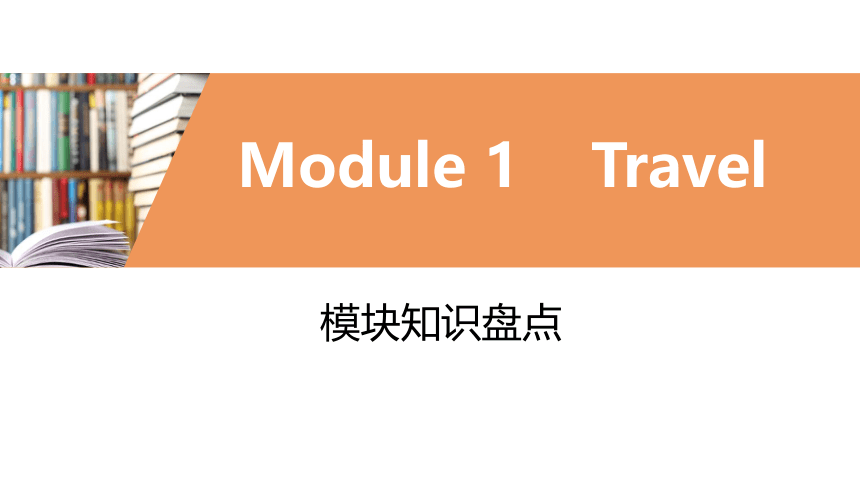 | |
| 格式 | pptx | ||
| 文件大小 | 429.3KB | ||
| 资源类型 | 教案 | ||
| 版本资源 | 外研版 | ||
| 科目 | 英语 | ||
| 更新时间 | 2022-08-29 17:19:34 | ||
图片预览

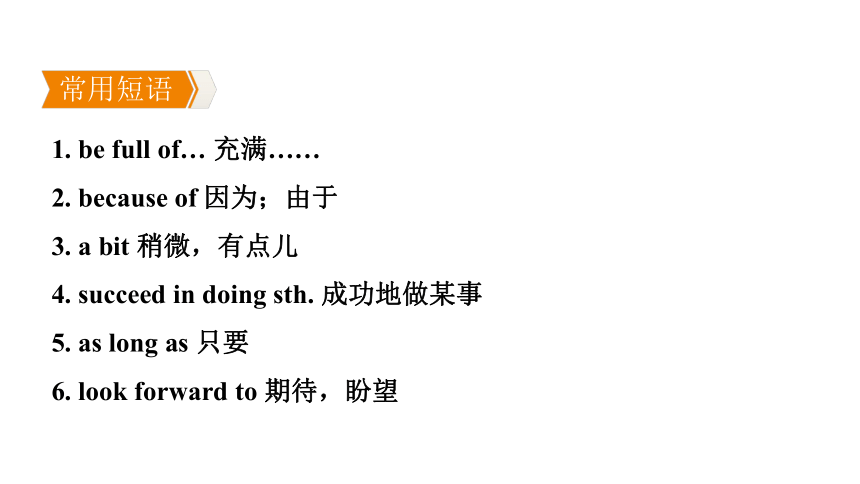

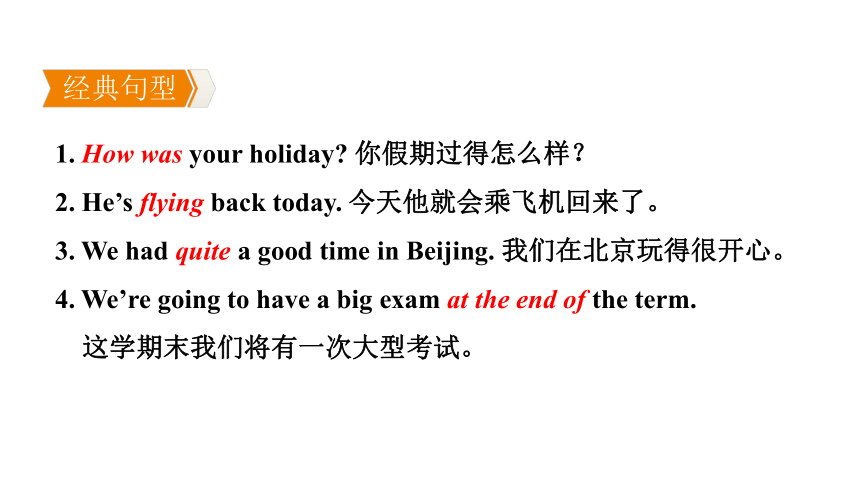
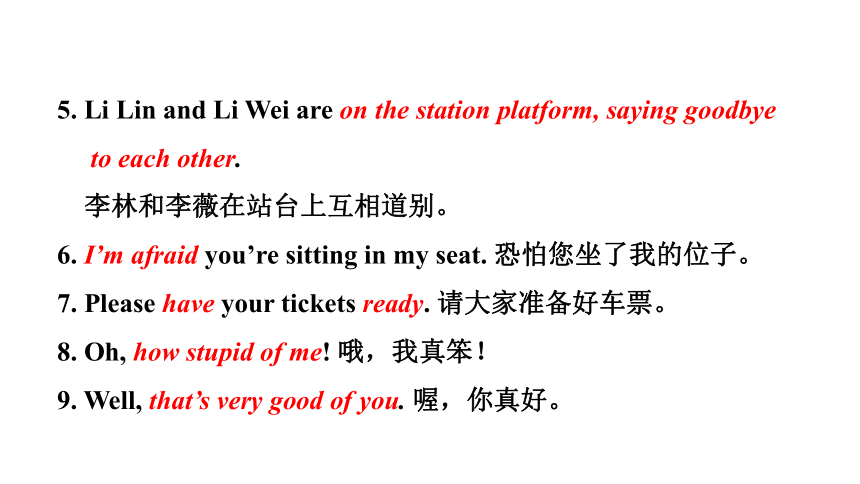

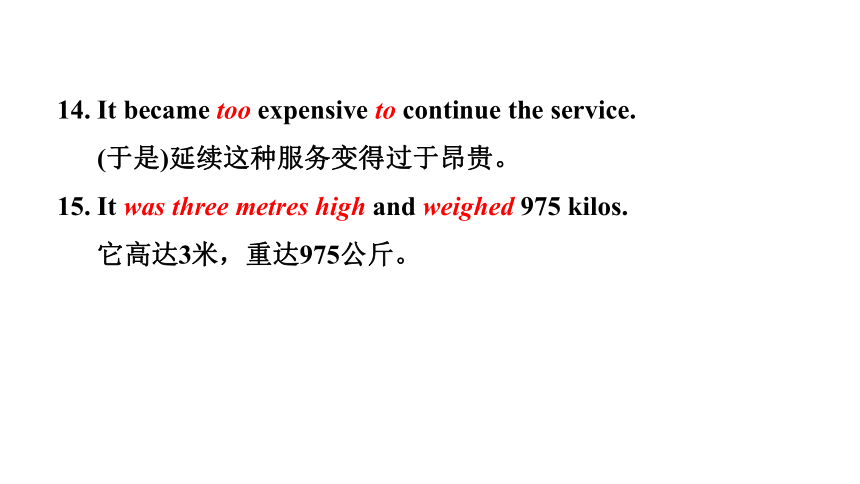
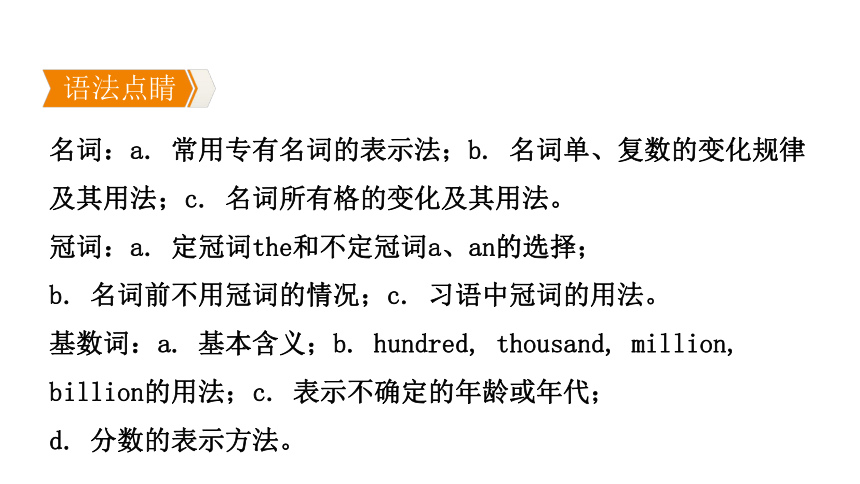
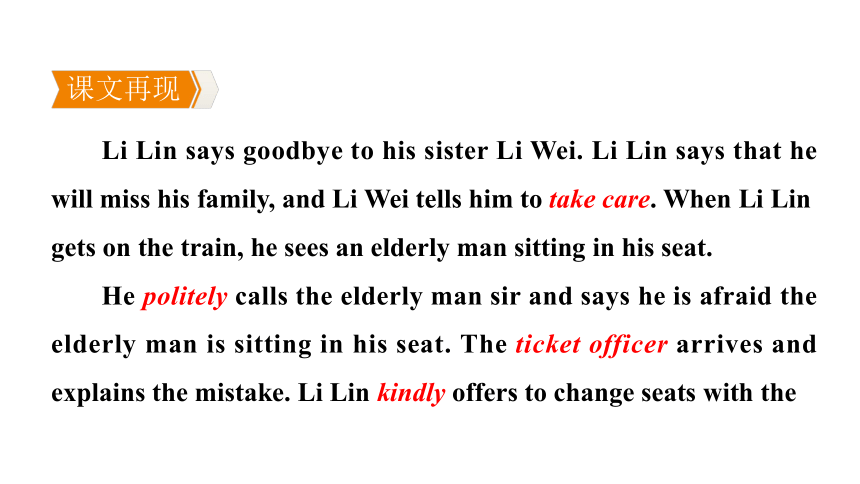

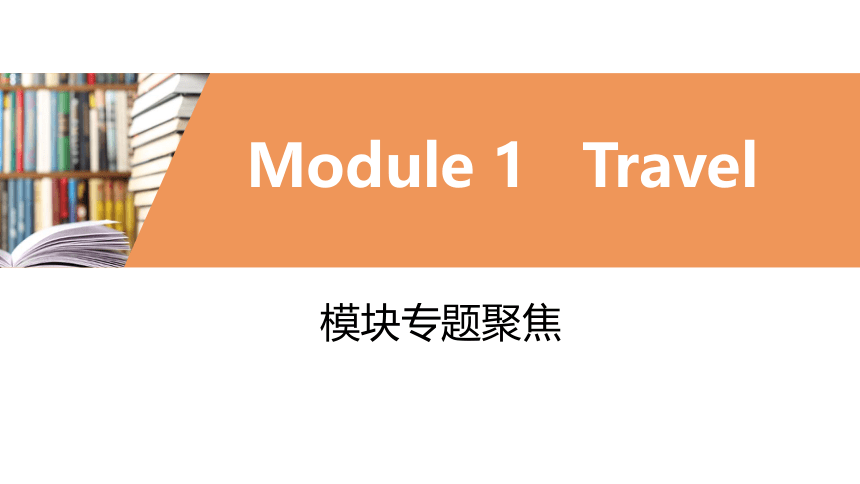

文档简介
(共90张PPT)
Module 1 Travel
模块知识盘点
常用短语
1. be full of… 充满……
2. because of 因为;由于
3. a bit 稍微,有点儿
4. succeed in doing sth. 成功地做某事
5. as long as 只要
6. look forward to 期待,盼望
7. say goodbye to sb. 向某人道别
8. take care (告别用语)多保重
9. get on 上(车、船、飞机等)
10. take off 脱去
11. offer to do sth. 主动提出做某事
12. see sb. off 为某人送行
经典句型
1. How was your holiday 你假期过得怎么样?
2. He’s flying back today. 今天他就会乘飞机回来了。
3. We had quite a good time in Beijing. 我们在北京玩得很开心。
4. We’re going to have a big exam at the end of the term.
这学期末我们将有一次大型考试。
5. Li Lin and Li Wei are on the station platform, saying goodbye
to each other.
李林和李薇在站台上互相道别。
6. I’m afraid you’re sitting in my seat. 恐怕您坐了我的位子。
7. Please have your tickets ready. 请大家准备好车票。
8. Oh, how stupid of me! 哦,我真笨!
9. Well, that’s very good of you. 喔,你真好。
10. He is surprised to see Li Lin. 见到李林他感到意外。
11. What a surprise! 太意外了!
12. Make sure you get to the airport in time for your plane.
确保你及时到达机场,赶上航班。
13. Flying at more than twice the speed of sound...
(由于)协和式飞机的飞行速度是声速的两倍多……
14. It became too expensive to continue the service.
(于是)延续这种服务变得过于昂贵。
15. It was three metres high and weighed 975 kilos.
它高达3米,重达975公斤。
语法点睛
名词:a. 常用专有名词的表示法;b. 名词单、复数的变化规律及其用法;c. 名词所有格的变化及其用法。
冠词:a. 定冠词the和不定冠词a、an的选择;
b. 名词前不用冠词的情况;c. 习语中冠词的用法。
基数词:a. 基本含义;b. hundred, thousand, million, billion的用法;c. 表示不确定的年龄或年代;
d. 分数的表示方法。
课文再现
Li Lin says goodbye to his sister Li Wei. Li Lin says that he will miss his family, and Li Wei tells him to take care. When Li Lin gets on the train, he sees an elderly man sitting in his seat.
He politely calls the elderly man sir and says he is afraid the elderly man is sitting in his seat. The ticket officer arrives and explains the mistake. Li Lin kindly offers to change seats with the
elderly man, and goes to Car 9. There he sees his friend Wen Peng, who is happy to see him and tells him to take off his jacket, sit down and make himself comfortable.
Module 1 Travel
模块专题聚焦
巧品语法
语法精讲
名词、冠词和基数词
命题情报
1. 名词主要考查:a. 常用专有名词的表示法;
b. 名词单、复数的变化规律及其用法;
c. 名词所有格的变化及其用法。名词主要在单项选择题型中考查,是每年必考的内容。
2. 冠词是中考的常见考点,中考对冠词的考查主要集中在定冠词the和不定冠词a、an的选择、名词前不用冠词的情况以及习语中冠词的用法上。
3. 基数词是中考的必考考点。中考对基数词的考查主要集中在以下几个方面:
a. 基本含义的考查:基数词表“数量”,其后为可数名词;
b. 考查hundred,thousand,million,billion的用法:这些词与基数词搭配使用,其后不加-s,但与of构成固定短语修饰可数名词的复数时,其后加- s;
c. 表示不确定的年龄或年代;
d. 考查分数的表示方法:分子使用基数词,分母使用序数词,分子大于1时,分母的序数词为复数形式。
1名词
1. 名词的简单分类
专有名词 普通名词 国名、地名、人名、 团体、机构名称 可数名词 不可数名词 个体名词 集体名词 抽象名词 物质名词
China,Tony,NBA book, lamb, apple people, family, police beauty(美), experience (经验), youth(青春) water,
beef,
air
2. 可数名词的数(单数变复数)
规则变化 一般情况在词尾加-s map→maps,
girl→girls,
day→days
以s, x, ch, sh结尾的 名词加-es class→classes,
box→boxes,
watch→watches
以-f或-fe结尾 的名词 变-f或-fe为 v再加-es leaf→leaves,
knife→knives,
wife→wives
加-s belief→beliefs,
roof→roofs,
gulf→gulfs
以“辅音字母+y”结尾的名词,变y为i再加-es party→parties,
city→cities,
story→stories
以“元音字母+y”结 尾的名词加-s toy→toys,
boy→boys
以“辅音字母 +o”结尾的名词 有生命的 加-es hero→heroes,
potato→potatoes,
tomato→tomatoes
无生命的 加-s piano→pianos,
photo→photos,
radio→radios
以-oo结尾的名词加-s bamboo→bamboos,
zoo→zoos
不规则变化 改变名词中的元音字 母或其他形式 man→men,woman→women,
foot→feet,goose→geese,
mouse→mice
单复数相同 sheep, deer, fish, means
表示“某国人” “中日不变英法变,其他-s 加后边。” Chinese→Chinese,
Englishman→Englishmen,
American→Americans
用-ren作词尾构成复数 child→children
以man, woman开头的合成词 前后都变为复数 man doctor→men doctors
一般合成词只把最后 一个词变为复数 boy student→boy students
3. 名词的格
基本形式 ’s所有格 一般表示人或有生命事物的
名词所有格。
如:Kate’s computer
of所有格 一般表示无生命事物的名词
所有格。
如:the door of the room
双重所有格 of+名词所有格
如:a picture of Li’s
of所有格 of+名词性物主代词
如:a friend of mine
(1)双重所有格与“of+名词”结构含义不同。 He is a friend of your husband’s. 他是你丈夫的一个朋友。(强调你丈夫的朋友不止一个) He is a friend of your husband.
他是你丈夫的朋友。(强调他对你丈夫的友好)
(2) 表示共同拥有某物时,所有格加在最后一个名词上;表示分别拥有某物时,在两个名词后分别加-’s, 而且被修饰的名词用复数形式。
This is Kate and Jim’s desk.
这是凯特和吉姆的书桌。(共同拥有)
Those are Kate’s and Jim’s desks.
那些是凯特和吉姆的书桌。(分别拥有)
2冠词
1. 不定冠词a/an的用法
(1) a用在以辅音音素开头的单词前,an用在以元音音素(不是元音字母)开头的单词前。
There is a picture on the wall. 墙上有一幅图画。
An hour ago, an honest man accepted an honourabletask.
一个小时以前,一个诚实的人接受了一项光荣的任务。
(2) 用于单数可数名词前,表示“某一”、“一……”或“一个”,侧重表示种类;而one表示“一个”时,强调数量。
a bus(表示是一辆公交车,而不是一辆小汽车,也不是火车)
one bus(强调公交车是一辆,而不是两辆或三辆)
(3)表示基本单位,作“每一”讲。
10 yuan a kilo 1公斤10元钱
(4) 与专有名词连用,表示“某一个,一个叫……的人”。
A John is waiting for you at the gate.
一个叫约翰的人在门口等你。
(5) 用于视为一体的两个名词之前,意为“一副,一套”。
a knife and fork 一副刀叉 a desk and chair 一套桌椅
(6)用在序数词前,表示“再一,又一”。
You can try it a second time if you fail.
如果你失败了,你可以再试一次。
(7)用在某些固定短语中。
once upon a time 从前
take a look 看一看
catch a cold 感冒
a little 一点儿
a few 一些,少数
have a rest 休息
2. 定冠词the的用法
(1) 最基本的用法是“特指”:表示某个或某些特定的人或物。
Do you know the girl in a red skirt
你认识那个穿红色短裙的女孩吗?
Beijing is the capital of China.
北京是中国的首都。
(2) 再次提到上文提到过的人或物。
Tom has an apple. The apple is big and red.
汤姆有一个苹果。这个苹果又大又红。
There is a boy under the tree. The boy is my brother.
树下有一个男孩。这个男孩是我的弟弟。
(3)指谈话双方都知道的人或物。
Let’s go and give it to the teacher. 咱们去把它交给老师吧。
Open the door, please! 请打开门!
(4)用在形容词前,表示一类人。
the old 老人 the young 年轻人 the rich 富人
the poor 穷人 the deaf 耳聋的人 the blind 盲人
(5)用在序数词或形容词最高级前。
The first thing I want to say is to listen carefullyin class.
我想说的第一件事就是上课要认真听讲。
He is the tallest student in our class.
他是我们班个子最高的学生。
(6)用在表示方位的词前。
The sun rises in the east, and sets in the west.
太阳从东边升起,从西边落下。
(7)用在某些固定短语中。
in the morning 在早上
the day after tomorrow 后天
the next day 第二天
by the way 顺便问/提一下
at table 在吃饭 at the table 在桌子旁
at school 上学 at the school 在学校
go to bed 上床睡觉 go to the bed 朝床边走去
in hospital/prison 住院/坐牢
in the hospital/prison 在医院/在监狱
in future 今后 in the future 将来
in office 执政 in the office 在办公室
[拓展]有无定冠词意义不同的词组:
3基数词
(1)表示“确数”与“概数”。
确数: 基数词+hundred/thousand/million+名词复数
概数: hundreds/thousands/millions of+名词复数
There are hundreds of people in the hall. 大厅里有数百人。
(2)表示不确定的年龄或年代。
in his forties 在他四十多岁时
in the 1870s/1870’s 在19世纪70年代
(3) 分数表示法:①分子用基数词,分母用序数词;
②分子在前,分母在后;③当分子大于1时,分母用复数形式。
one third 三分之一
two thirds 三分之二
(4) 基数词表示顺序的方法:名词+基数词(首字母均大写)=the+序数词+名词。
Lesson One=the first lesson 第一课
1. |东营中考|What ______ will global warming(全球变暖) bring us Scientists have given us a clear list.
A. news B. dangers
C. courses D. advantages
考点直击
B
2. |天水中考|The Belt and Road Initiative(一带一路倡议) will help China improve the ______ withthose related countries, especially Pakistan(巴基斯坦).
A. relationship B. agreement
C. environment D. information
3. |广安中考|—How many ______ are there
—About fifty.
A. tomatos B. tomatoes C. tomato
A
B
4. —How many ______ doctors are there in your
hospital, David
— ______ them ______ over one hundred.
A. woman; The number of; is
B. women; A number of; are
C. woman; A number of; is
D. women; The number of; is
D
5. |达州中考|—Could you please offer me some ______ in my research
—Yes, sure.
A. idea B. message
C. suggestion D. advice
D
【解析】考查可数名词和不可数名词。本句中有some,后接可数名词复数形式或不可数名词。idea, message, suggestion均为可数名词,且为单数形式,故排除。故选D。
6. |黄冈中考|—I’m thirsty, Mum. I’d like somethingto drink.
—We only have some ______ in the fridge.
A. oranges B. ice cream
C. juice D. cheese
7. |杭州中考|I am tired. This is not the right ______ to ask me to go for a walk.
A. moment B. chance
C. place D. season
C
A
8. |安顺中考|—Excuse me! Is this ______ new house
—Yes, it’s ______ . The parents of them bought it
last September.
A. Lucy and Lily’s; theirs
B. Lucy’s and Lily’s; them
C. Lucy’s and Lily’s; theirs
D. Lucy and Lily’s; them
A
9. |天水中考| ______ of the farmland here ______ with rice.
A. Two thirds; is covering
B. Two third; is covered
C. Second third; are covering
D. Two thirds; is covered
D
10. |白银中考|Mr Black is a teacher of ______ . She and her classmates like him very much.
A. my sister B. my sister’s
C. my sisters D. my sisters’
11. |广州中考| Yesterday for dinner I had a piece of beef, vegetables and ______ .
A. a few rice B. some rice
C. a little rices D. a rice
B
B
12. |铜仁中考|There are floors ______ in the building.
We live on ______ floor.
A. the ninth; the ninth
B. the ninth; nine
C. nine; the ninth
D. nine; nine
C
13. |绥化中考|We can see many______ on the hill in the picture.
A. sheeps B. sheep C. horse
B
【解析】many 后接可数名词复数,sheep 单复数同形。
14. |龙东中考|—Whose room is this Is it the ______
—Yes, it is ______ .
A. twins’; Tom and Tim’s
B. twin’s; Tom’s and Tim’s
C. twins’; Tom and Tim
A
【解析】the twins是指两人,且词尾以s结尾,所以其所有格形式只需要加“’”,表示“双胞胎同住的”。由语境可知,这个房间是两人共同所有的,所以在最后一个人名后加’s。
15. |遵义中考|A: Can I help you, madam
B: I want ______ .
A. two boxes of apple
B. two glass of water
C. two bowls of porridge
C
【解析】 “两箱苹果”应用two boxes of apples,“两杯水”应用two glasses of water。故选C。
16. |河南中考|Mr Smith is ______ old man and he
usually walks his dog after ______ supper.
A. a; the B. an; a
C. an; / D. the; /
C
【解析】句意:史密斯先生是一位老人,他晚饭后通常去遛狗。old是以元音音素开头的单词,所以前面应该用an;表示三餐的名词前不加冠词。故选C。
17. |西宁中考|Teachers always tell us to try to be ______ honest student today and ______ useful man tomorrow.
A. a; an B. an; a
C. an; an D. a; a
B
18. |随州中考|It’s ______ useless book to children.
Put it into ______ left drawer and never read it.
A. a; the B. an; the
C. a; a D. an; a
A
【解析】 useless是以辅音音素开头的单词,故用a表示泛指,排除B、D;特指“左边的抽屉”要用定冠词the。故选A。
19. |遂宁中考|—What do you think of Wang Wei
—He is ______ honest boy, and always helps ______ old.
A. a; the B. an; the C. the; an
B
【解析】 honest是以元音音素开头的单词,故其前用不定冠词an;the old表示“老人”。
20. |黔西南中考|—How was ______ dinner at Mike’s house
—It was great. Mike’s mum is ______ wonderful cook.
A. a; the B. the; a
C. the; the D. a; an
B
21. |广东中考|Eric is not going to Nanjing by ______ plane. Instead, he is taking ______ train.
A. /; a B. a; /
C. a; the D. the; a
A
【解析】 by plane是固定短语,中间不加冠词;take a train意为“乘火车”。
22. |来宾中考|I have ______ European pen friend, and
he likes playing ______ guitar.
A. an; / B. an; the
C. a; / D. a; the
23. |广东中考| ______ new study says that going to ______ bed late is harmful to our health.
A. /; / B. A; /
C. A; the D. The; the
D
B
24. |苏州中考|If we sit by ______ window of the train,
we’ll have ______ better view.
A. /; the B. /; a
C. the; a D. the; the
25. |南充中考|—Who’s ______ boy under the tree
—Bill. He’s ______ active boy.
A. a; an B. a; the
C. the; a D. the; an
C
D
26. |广东中考|It’s never too old to learn. Karl Marx began to learn English in his ______.
A. the fiftieth B. fiftieth
C. fifty D. fifties
D
【解析】 “in one’s+整十年龄复数”意为“在某人几十多岁的时候”,表示不确定的年龄。
27. |凉山中考|—Have you ever come to Xichang before
—Yes. This is my ______ visit to Xichang. I have come here twice before.
A. two B. second
C. three D. third
D
28. |兰州中考|Please turn to Page ______ and read the ______ story.
A. Ten; two B. Ten; second
C. Tenth; second D. Tenth; two
B
【解析】基数词和序数词都可以表示顺序,但表达方式不同:名词+基数词(首字母均大写)=the+序数词+名词。
29. |淮安中考|Sam enjoys collecting. He has collectedover three ______ stamps.
A. hundred B. hundreds
C. hundred of D. hundreds of
30. |宜宾中考|In this test, we’re asked to write a passage of about ______.
A. 80-words B. 80-word
C. 80 words D. 80 words’
A
C
31. |广东中考|According to a survey, four out of five women do housework at home, but only ______ of men would do it.
A. four fifth B. four fifths
C. two fifth D. two fifths
D
32. |湘西中考改编|—Excuse me, Mary. Can you read “198” in English
—Yes, of course. ______.
A. One hundred ninety eight
B. One hundred nine eight
C. One hundred and ninety-eight
C
33. |黔西南中考|The Smiths are watching the men’s table tennis match at the moment. (选出与画线部分意思相近的选项)
______
A. Mr Smith
B. Mrs Smith
C. The Smith family
D. Mr Smith and his son
C
34. |黄石中考|China, ______ home of tea, has ______history of more than 4,000 years.
A. the; the B. a; a
C. a; the D. the; a
35. |莱芜中考|On ______ sunny afternoon, I went bike riding with my parents.
A. an B. a
C. the D. /
D
B
介绍旅游经历及感受
本模块以“旅游”为话题,介绍旅游经历及感受。旅游是一种享受,它可以帮助我们放松自己,增长见识,感悟人生,可以让我们欣赏世界各地的风景名胜,了解各地的风俗习惯。
妙解写作
写 作 案 例
假如你是大明,请你根据下面的提示,写一篇英语日记,记述你5月30日参加的一次短途旅游活动,并简要谈谈你的感受。
内容提示:
1. 活动地点:距离你家大约10公里的乡下;
2. 交通工具:骑自行车;
3. 活动时间:上午8点出发,9点到达,下午5点半返回;
4. 活动内容:自定(至少谈及三项活动)。
要求:1. 要点齐全,可适当发挥;
2. 文中不得出现真实的人名和校名;
3. 词数80左右,文章开头已给出,不计入总词数。
May 30th
Today I went for a pleasant trip with my friends. ___________________________________________________________________________________________________________________________________________________________________________ _________________________________________________________
素 材 积 累
词汇库
trip 旅行,旅游
countryside 乡下
journey 旅行
start 启程
arrive 到达
relaxed 轻松的
短语箱
by bike 骑自行车
go for a pleasant trip with 和……进行一次愉快的旅游
play a game 做游戏
enjoy oneself 玩得高兴
places of interest 名胜古迹
be full of 充满……
the best season to do 做……的最好季节
句式链
① I think the best place to visit is…
我认为参观的最佳地点是……
② I like to travel by… 我喜欢乘……旅行。
③ Last summer, I went to… 去年夏天,我去了……
④ We saw many places of interest there.
在那里我们看到了很多名胜古迹。
⑤ First, we visited…Then…Finally…
首先,我们参观了……然后……最后……
⑥ I enjoyed my trip to…this summer.
我喜欢我今年夏天的……之旅。
⑦ The journey was full of pleasant experiences.
这次旅行充满了愉快的经历。
⑧ I felt tired but very excited. 我感觉累,但是很兴奋。
五 步 妙 解
审
体裁 应用文 话题 介绍一次旅游经历
时态 一般过去时 人称 第一人称
段落 布局 开头:概括介绍。 主体:适当扩展内容,对活动内容进行介绍。 结尾:进行总括。 谴
(1)We went to the countryside. The countryside is about 10 kilometres away from my house.
将以上两个简单句合并成一个复合句:
_____________________________________________________
(2)It was not far. We went there by bike.
将以上两个简单句合并为含有because的原因状语从句:
_____________________________________________________
Because it was not far, we went there by bike.
We went to the countryside that is about 10 kilometres away from my house.
模
开篇点题
从各方面
进行介绍
进行总括
Today I went for a pleasant trip with my friends.
We went to...10 kilometres away...
We went there by...
When we got there, we made...
Today, we had great fun.
May 30th
Today I went for a pleasant trip with my friends. We went to the countryside that is about 10 kilometres away from my house. Because it was not far, we went there by bike. We started at 8 o’clock and arrived at 9 o’clock. When we got there, we made a plan to play a game together, and we enjoyed ourselves. After lunch,
润
the weather was so hot, so we decided to go swimming and we felt relaxed. In the afternoon, we sang songs and danced together. We went back at half past five. Today, we had great fun.
润
点
本篇文章条理清晰,结构合理。开篇介绍了作者的旅游经历,接下来从各方面介绍了作者的活动内容。
因为是日记,所以文章用一般过去时,符合此类文章的写作要求。
小 试 身 手
|金华中考| 来自美国的Ronnie Smith是你校新来的英语教师,下面是他本周末的出行意向表。
This Weekend’s Trip
Purpose(目的): to learn about Chinese culture
The place to go: somewhere special
Transportation: by bus, by bike or on foot
假设你是Ronnie的学生李明,本周末很乐意当他的向导。请你根据Ronnie的出行意向,选择一种你喜欢的方案,用英语写一封email发给Ronnie。
Plan A Plan B
Where to visit Art Museum Culture Village
How to go … …
What to do Enjoy Chinese paintings Learn about paper-utting… Watch traditional shows Enjoy local food …
要求:1. 内容必须包括你所选方案对应的表中信息,可适当发挥;
2. 文中不得出现真实的人名、校名与地名;
3. 词数80—100,开头已写好,但不计入总词数。
To: Ronnie@ From: Liming123@
Subject: This Weekend’s Trip Dear Ronnie, I’m very glad to be your guide. The place I advise you to visit is _________________________________________________________ _________________________________________________________ Yours, Li Ming One possible version:
Dear Ronnie,
I’m very glad to be your guide. The place I advise you to visit is the Culture Village. I think it’s the best place to learn Chinese culture that you’re interested in. We’d better go there by bus, because it’s a little far from our school.
The moment we get there, we can watch traditional shows which may be different from those in your country. They are so interesting that you’ll know a lot
about the lifestyle in villages. Then we can enjoy local food, for example, jiaozi, a kind of dumplings. If you prefer, you can learn to make it in person.
How about taking a camera with you so that we can take some photos I’m sure we’ll enjoy ourselves there.
Yours,
Li Ming
“主旨大意法”解阅读理解题
做主旨大意题时一定要注意文章的首尾两段。如果首尾两段的主旨表达是一致的,那么文章的主旨便是两段重复表明的语句。如果首尾两段的主旨表达不一致,则需要观察文章的段落篇幅量是倾向于首段还是尾段,从而确定主旨段落。在此过程中,观察篇幅量只需跳读文章段落的首句和尾句即可,无需细读段落内容,
培优课堂
以节省时间。如果文章只有一段,则注意文章的首句及尾句,然后用以上方法确定主旨句。此外,标题选择即为主旨句的压缩表达,注意抓住主旨句进行主要词汇的提炼,把一个句子提炼为几个关键词,即是对主旨大意进行概括归纳的标题。
【典例】
Last year, a special kind of glove came out. It was invented to help blind people to learn Braille, which is a special system for the blind to read by touching. Shaking motors(震动马达) are put on each finger of the glove. They can make different sounds to tell a user which letter he is touching. Recently, two British college students have invented another special kind of glove for the blind. It can make the user feel small and quick movements. An
An ultrasonic sensor(超声波传感器) with a battery is put on the back of the glove. When the user wearing the glove is close to an object(物体), ultrasonic waves(超声波) from the glove are sent out(发出). As soon as they hit the object in front, the waves will return to the glove. Then the waves cause the glove to shake. And the ultrasonic sensor makes different kinds of sounds. The sounds make the user know how far he is from the object.
In the college invention competition, the two students got first prize and won 1,540 pounds. One of the designers said, “Now the ultrasonic sensor on the glove is quite large. We’re going to use the money to develop a smaller and lighter ultrasonic sensor.”
【题目】
What is the best title for this passage
A. The Way to Make Gloves
B. Two Kinds of Special Gloves
C. An Ultrasonic Sensor and Shaking Motors
【答案】 B
【解析】 本题为标题概括题。文章主要介绍了两种特殊的手套。因此,最佳标题为“Two Kinds of Special Gloves”。故选B。
谢 谢 观 看!
Module 1 Travel
模块知识盘点
常用短语
1. be full of… 充满……
2. because of 因为;由于
3. a bit 稍微,有点儿
4. succeed in doing sth. 成功地做某事
5. as long as 只要
6. look forward to 期待,盼望
7. say goodbye to sb. 向某人道别
8. take care (告别用语)多保重
9. get on 上(车、船、飞机等)
10. take off 脱去
11. offer to do sth. 主动提出做某事
12. see sb. off 为某人送行
经典句型
1. How was your holiday 你假期过得怎么样?
2. He’s flying back today. 今天他就会乘飞机回来了。
3. We had quite a good time in Beijing. 我们在北京玩得很开心。
4. We’re going to have a big exam at the end of the term.
这学期末我们将有一次大型考试。
5. Li Lin and Li Wei are on the station platform, saying goodbye
to each other.
李林和李薇在站台上互相道别。
6. I’m afraid you’re sitting in my seat. 恐怕您坐了我的位子。
7. Please have your tickets ready. 请大家准备好车票。
8. Oh, how stupid of me! 哦,我真笨!
9. Well, that’s very good of you. 喔,你真好。
10. He is surprised to see Li Lin. 见到李林他感到意外。
11. What a surprise! 太意外了!
12. Make sure you get to the airport in time for your plane.
确保你及时到达机场,赶上航班。
13. Flying at more than twice the speed of sound...
(由于)协和式飞机的飞行速度是声速的两倍多……
14. It became too expensive to continue the service.
(于是)延续这种服务变得过于昂贵。
15. It was three metres high and weighed 975 kilos.
它高达3米,重达975公斤。
语法点睛
名词:a. 常用专有名词的表示法;b. 名词单、复数的变化规律及其用法;c. 名词所有格的变化及其用法。
冠词:a. 定冠词the和不定冠词a、an的选择;
b. 名词前不用冠词的情况;c. 习语中冠词的用法。
基数词:a. 基本含义;b. hundred, thousand, million, billion的用法;c. 表示不确定的年龄或年代;
d. 分数的表示方法。
课文再现
Li Lin says goodbye to his sister Li Wei. Li Lin says that he will miss his family, and Li Wei tells him to take care. When Li Lin gets on the train, he sees an elderly man sitting in his seat.
He politely calls the elderly man sir and says he is afraid the elderly man is sitting in his seat. The ticket officer arrives and explains the mistake. Li Lin kindly offers to change seats with the
elderly man, and goes to Car 9. There he sees his friend Wen Peng, who is happy to see him and tells him to take off his jacket, sit down and make himself comfortable.
Module 1 Travel
模块专题聚焦
巧品语法
语法精讲
名词、冠词和基数词
命题情报
1. 名词主要考查:a. 常用专有名词的表示法;
b. 名词单、复数的变化规律及其用法;
c. 名词所有格的变化及其用法。名词主要在单项选择题型中考查,是每年必考的内容。
2. 冠词是中考的常见考点,中考对冠词的考查主要集中在定冠词the和不定冠词a、an的选择、名词前不用冠词的情况以及习语中冠词的用法上。
3. 基数词是中考的必考考点。中考对基数词的考查主要集中在以下几个方面:
a. 基本含义的考查:基数词表“数量”,其后为可数名词;
b. 考查hundred,thousand,million,billion的用法:这些词与基数词搭配使用,其后不加-s,但与of构成固定短语修饰可数名词的复数时,其后加- s;
c. 表示不确定的年龄或年代;
d. 考查分数的表示方法:分子使用基数词,分母使用序数词,分子大于1时,分母的序数词为复数形式。
1名词
1. 名词的简单分类
专有名词 普通名词 国名、地名、人名、 团体、机构名称 可数名词 不可数名词 个体名词 集体名词 抽象名词 物质名词
China,Tony,NBA book, lamb, apple people, family, police beauty(美), experience (经验), youth(青春) water,
beef,
air
2. 可数名词的数(单数变复数)
规则变化 一般情况在词尾加-s map→maps,
girl→girls,
day→days
以s, x, ch, sh结尾的 名词加-es class→classes,
box→boxes,
watch→watches
以-f或-fe结尾 的名词 变-f或-fe为 v再加-es leaf→leaves,
knife→knives,
wife→wives
加-s belief→beliefs,
roof→roofs,
gulf→gulfs
以“辅音字母+y”结尾的名词,变y为i再加-es party→parties,
city→cities,
story→stories
以“元音字母+y”结 尾的名词加-s toy→toys,
boy→boys
以“辅音字母 +o”结尾的名词 有生命的 加-es hero→heroes,
potato→potatoes,
tomato→tomatoes
无生命的 加-s piano→pianos,
photo→photos,
radio→radios
以-oo结尾的名词加-s bamboo→bamboos,
zoo→zoos
不规则变化 改变名词中的元音字 母或其他形式 man→men,woman→women,
foot→feet,goose→geese,
mouse→mice
单复数相同 sheep, deer, fish, means
表示“某国人” “中日不变英法变,其他-s 加后边。” Chinese→Chinese,
Englishman→Englishmen,
American→Americans
用-ren作词尾构成复数 child→children
以man, woman开头的合成词 前后都变为复数 man doctor→men doctors
一般合成词只把最后 一个词变为复数 boy student→boy students
3. 名词的格
基本形式 ’s所有格 一般表示人或有生命事物的
名词所有格。
如:Kate’s computer
of所有格 一般表示无生命事物的名词
所有格。
如:the door of the room
双重所有格 of+名词所有格
如:a picture of Li’s
of所有格 of+名词性物主代词
如:a friend of mine
(1)双重所有格与“of+名词”结构含义不同。 He is a friend of your husband’s. 他是你丈夫的一个朋友。(强调你丈夫的朋友不止一个) He is a friend of your husband.
他是你丈夫的朋友。(强调他对你丈夫的友好)
(2) 表示共同拥有某物时,所有格加在最后一个名词上;表示分别拥有某物时,在两个名词后分别加-’s, 而且被修饰的名词用复数形式。
This is Kate and Jim’s desk.
这是凯特和吉姆的书桌。(共同拥有)
Those are Kate’s and Jim’s desks.
那些是凯特和吉姆的书桌。(分别拥有)
2冠词
1. 不定冠词a/an的用法
(1) a用在以辅音音素开头的单词前,an用在以元音音素(不是元音字母)开头的单词前。
There is a picture on the wall. 墙上有一幅图画。
An hour ago, an honest man accepted an honourabletask.
一个小时以前,一个诚实的人接受了一项光荣的任务。
(2) 用于单数可数名词前,表示“某一”、“一……”或“一个”,侧重表示种类;而one表示“一个”时,强调数量。
a bus(表示是一辆公交车,而不是一辆小汽车,也不是火车)
one bus(强调公交车是一辆,而不是两辆或三辆)
(3)表示基本单位,作“每一”讲。
10 yuan a kilo 1公斤10元钱
(4) 与专有名词连用,表示“某一个,一个叫……的人”。
A John is waiting for you at the gate.
一个叫约翰的人在门口等你。
(5) 用于视为一体的两个名词之前,意为“一副,一套”。
a knife and fork 一副刀叉 a desk and chair 一套桌椅
(6)用在序数词前,表示“再一,又一”。
You can try it a second time if you fail.
如果你失败了,你可以再试一次。
(7)用在某些固定短语中。
once upon a time 从前
take a look 看一看
catch a cold 感冒
a little 一点儿
a few 一些,少数
have a rest 休息
2. 定冠词the的用法
(1) 最基本的用法是“特指”:表示某个或某些特定的人或物。
Do you know the girl in a red skirt
你认识那个穿红色短裙的女孩吗?
Beijing is the capital of China.
北京是中国的首都。
(2) 再次提到上文提到过的人或物。
Tom has an apple. The apple is big and red.
汤姆有一个苹果。这个苹果又大又红。
There is a boy under the tree. The boy is my brother.
树下有一个男孩。这个男孩是我的弟弟。
(3)指谈话双方都知道的人或物。
Let’s go and give it to the teacher. 咱们去把它交给老师吧。
Open the door, please! 请打开门!
(4)用在形容词前,表示一类人。
the old 老人 the young 年轻人 the rich 富人
the poor 穷人 the deaf 耳聋的人 the blind 盲人
(5)用在序数词或形容词最高级前。
The first thing I want to say is to listen carefullyin class.
我想说的第一件事就是上课要认真听讲。
He is the tallest student in our class.
他是我们班个子最高的学生。
(6)用在表示方位的词前。
The sun rises in the east, and sets in the west.
太阳从东边升起,从西边落下。
(7)用在某些固定短语中。
in the morning 在早上
the day after tomorrow 后天
the next day 第二天
by the way 顺便问/提一下
at table 在吃饭 at the table 在桌子旁
at school 上学 at the school 在学校
go to bed 上床睡觉 go to the bed 朝床边走去
in hospital/prison 住院/坐牢
in the hospital/prison 在医院/在监狱
in future 今后 in the future 将来
in office 执政 in the office 在办公室
[拓展]有无定冠词意义不同的词组:
3基数词
(1)表示“确数”与“概数”。
确数: 基数词+hundred/thousand/million+名词复数
概数: hundreds/thousands/millions of+名词复数
There are hundreds of people in the hall. 大厅里有数百人。
(2)表示不确定的年龄或年代。
in his forties 在他四十多岁时
in the 1870s/1870’s 在19世纪70年代
(3) 分数表示法:①分子用基数词,分母用序数词;
②分子在前,分母在后;③当分子大于1时,分母用复数形式。
one third 三分之一
two thirds 三分之二
(4) 基数词表示顺序的方法:名词+基数词(首字母均大写)=the+序数词+名词。
Lesson One=the first lesson 第一课
1. |东营中考|What ______ will global warming(全球变暖) bring us Scientists have given us a clear list.
A. news B. dangers
C. courses D. advantages
考点直击
B
2. |天水中考|The Belt and Road Initiative(一带一路倡议) will help China improve the ______ withthose related countries, especially Pakistan(巴基斯坦).
A. relationship B. agreement
C. environment D. information
3. |广安中考|—How many ______ are there
—About fifty.
A. tomatos B. tomatoes C. tomato
A
B
4. —How many ______ doctors are there in your
hospital, David
— ______ them ______ over one hundred.
A. woman; The number of; is
B. women; A number of; are
C. woman; A number of; is
D. women; The number of; is
D
5. |达州中考|—Could you please offer me some ______ in my research
—Yes, sure.
A. idea B. message
C. suggestion D. advice
D
【解析】考查可数名词和不可数名词。本句中有some,后接可数名词复数形式或不可数名词。idea, message, suggestion均为可数名词,且为单数形式,故排除。故选D。
6. |黄冈中考|—I’m thirsty, Mum. I’d like somethingto drink.
—We only have some ______ in the fridge.
A. oranges B. ice cream
C. juice D. cheese
7. |杭州中考|I am tired. This is not the right ______ to ask me to go for a walk.
A. moment B. chance
C. place D. season
C
A
8. |安顺中考|—Excuse me! Is this ______ new house
—Yes, it’s ______ . The parents of them bought it
last September.
A. Lucy and Lily’s; theirs
B. Lucy’s and Lily’s; them
C. Lucy’s and Lily’s; theirs
D. Lucy and Lily’s; them
A
9. |天水中考| ______ of the farmland here ______ with rice.
A. Two thirds; is covering
B. Two third; is covered
C. Second third; are covering
D. Two thirds; is covered
D
10. |白银中考|Mr Black is a teacher of ______ . She and her classmates like him very much.
A. my sister B. my sister’s
C. my sisters D. my sisters’
11. |广州中考| Yesterday for dinner I had a piece of beef, vegetables and ______ .
A. a few rice B. some rice
C. a little rices D. a rice
B
B
12. |铜仁中考|There are floors ______ in the building.
We live on ______ floor.
A. the ninth; the ninth
B. the ninth; nine
C. nine; the ninth
D. nine; nine
C
13. |绥化中考|We can see many______ on the hill in the picture.
A. sheeps B. sheep C. horse
B
【解析】many 后接可数名词复数,sheep 单复数同形。
14. |龙东中考|—Whose room is this Is it the ______
—Yes, it is ______ .
A. twins’; Tom and Tim’s
B. twin’s; Tom’s and Tim’s
C. twins’; Tom and Tim
A
【解析】the twins是指两人,且词尾以s结尾,所以其所有格形式只需要加“’”,表示“双胞胎同住的”。由语境可知,这个房间是两人共同所有的,所以在最后一个人名后加’s。
15. |遵义中考|A: Can I help you, madam
B: I want ______ .
A. two boxes of apple
B. two glass of water
C. two bowls of porridge
C
【解析】 “两箱苹果”应用two boxes of apples,“两杯水”应用two glasses of water。故选C。
16. |河南中考|Mr Smith is ______ old man and he
usually walks his dog after ______ supper.
A. a; the B. an; a
C. an; / D. the; /
C
【解析】句意:史密斯先生是一位老人,他晚饭后通常去遛狗。old是以元音音素开头的单词,所以前面应该用an;表示三餐的名词前不加冠词。故选C。
17. |西宁中考|Teachers always tell us to try to be ______ honest student today and ______ useful man tomorrow.
A. a; an B. an; a
C. an; an D. a; a
B
18. |随州中考|It’s ______ useless book to children.
Put it into ______ left drawer and never read it.
A. a; the B. an; the
C. a; a D. an; a
A
【解析】 useless是以辅音音素开头的单词,故用a表示泛指,排除B、D;特指“左边的抽屉”要用定冠词the。故选A。
19. |遂宁中考|—What do you think of Wang Wei
—He is ______ honest boy, and always helps ______ old.
A. a; the B. an; the C. the; an
B
【解析】 honest是以元音音素开头的单词,故其前用不定冠词an;the old表示“老人”。
20. |黔西南中考|—How was ______ dinner at Mike’s house
—It was great. Mike’s mum is ______ wonderful cook.
A. a; the B. the; a
C. the; the D. a; an
B
21. |广东中考|Eric is not going to Nanjing by ______ plane. Instead, he is taking ______ train.
A. /; a B. a; /
C. a; the D. the; a
A
【解析】 by plane是固定短语,中间不加冠词;take a train意为“乘火车”。
22. |来宾中考|I have ______ European pen friend, and
he likes playing ______ guitar.
A. an; / B. an; the
C. a; / D. a; the
23. |广东中考| ______ new study says that going to ______ bed late is harmful to our health.
A. /; / B. A; /
C. A; the D. The; the
D
B
24. |苏州中考|If we sit by ______ window of the train,
we’ll have ______ better view.
A. /; the B. /; a
C. the; a D. the; the
25. |南充中考|—Who’s ______ boy under the tree
—Bill. He’s ______ active boy.
A. a; an B. a; the
C. the; a D. the; an
C
D
26. |广东中考|It’s never too old to learn. Karl Marx began to learn English in his ______.
A. the fiftieth B. fiftieth
C. fifty D. fifties
D
【解析】 “in one’s+整十年龄复数”意为“在某人几十多岁的时候”,表示不确定的年龄。
27. |凉山中考|—Have you ever come to Xichang before
—Yes. This is my ______ visit to Xichang. I have come here twice before.
A. two B. second
C. three D. third
D
28. |兰州中考|Please turn to Page ______ and read the ______ story.
A. Ten; two B. Ten; second
C. Tenth; second D. Tenth; two
B
【解析】基数词和序数词都可以表示顺序,但表达方式不同:名词+基数词(首字母均大写)=the+序数词+名词。
29. |淮安中考|Sam enjoys collecting. He has collectedover three ______ stamps.
A. hundred B. hundreds
C. hundred of D. hundreds of
30. |宜宾中考|In this test, we’re asked to write a passage of about ______.
A. 80-words B. 80-word
C. 80 words D. 80 words’
A
C
31. |广东中考|According to a survey, four out of five women do housework at home, but only ______ of men would do it.
A. four fifth B. four fifths
C. two fifth D. two fifths
D
32. |湘西中考改编|—Excuse me, Mary. Can you read “198” in English
—Yes, of course. ______.
A. One hundred ninety eight
B. One hundred nine eight
C. One hundred and ninety-eight
C
33. |黔西南中考|The Smiths are watching the men’s table tennis match at the moment. (选出与画线部分意思相近的选项)
______
A. Mr Smith
B. Mrs Smith
C. The Smith family
D. Mr Smith and his son
C
34. |黄石中考|China, ______ home of tea, has ______history of more than 4,000 years.
A. the; the B. a; a
C. a; the D. the; a
35. |莱芜中考|On ______ sunny afternoon, I went bike riding with my parents.
A. an B. a
C. the D. /
D
B
介绍旅游经历及感受
本模块以“旅游”为话题,介绍旅游经历及感受。旅游是一种享受,它可以帮助我们放松自己,增长见识,感悟人生,可以让我们欣赏世界各地的风景名胜,了解各地的风俗习惯。
妙解写作
写 作 案 例
假如你是大明,请你根据下面的提示,写一篇英语日记,记述你5月30日参加的一次短途旅游活动,并简要谈谈你的感受。
内容提示:
1. 活动地点:距离你家大约10公里的乡下;
2. 交通工具:骑自行车;
3. 活动时间:上午8点出发,9点到达,下午5点半返回;
4. 活动内容:自定(至少谈及三项活动)。
要求:1. 要点齐全,可适当发挥;
2. 文中不得出现真实的人名和校名;
3. 词数80左右,文章开头已给出,不计入总词数。
May 30th
Today I went for a pleasant trip with my friends. ___________________________________________________________________________________________________________________________________________________________________________ _________________________________________________________
素 材 积 累
词汇库
trip 旅行,旅游
countryside 乡下
journey 旅行
start 启程
arrive 到达
relaxed 轻松的
短语箱
by bike 骑自行车
go for a pleasant trip with 和……进行一次愉快的旅游
play a game 做游戏
enjoy oneself 玩得高兴
places of interest 名胜古迹
be full of 充满……
the best season to do 做……的最好季节
句式链
① I think the best place to visit is…
我认为参观的最佳地点是……
② I like to travel by… 我喜欢乘……旅行。
③ Last summer, I went to… 去年夏天,我去了……
④ We saw many places of interest there.
在那里我们看到了很多名胜古迹。
⑤ First, we visited…Then…Finally…
首先,我们参观了……然后……最后……
⑥ I enjoyed my trip to…this summer.
我喜欢我今年夏天的……之旅。
⑦ The journey was full of pleasant experiences.
这次旅行充满了愉快的经历。
⑧ I felt tired but very excited. 我感觉累,但是很兴奋。
五 步 妙 解
审
体裁 应用文 话题 介绍一次旅游经历
时态 一般过去时 人称 第一人称
段落 布局 开头:概括介绍。 主体:适当扩展内容,对活动内容进行介绍。 结尾:进行总括。 谴
(1)We went to the countryside. The countryside is about 10 kilometres away from my house.
将以上两个简单句合并成一个复合句:
_____________________________________________________
(2)It was not far. We went there by bike.
将以上两个简单句合并为含有because的原因状语从句:
_____________________________________________________
Because it was not far, we went there by bike.
We went to the countryside that is about 10 kilometres away from my house.
模
开篇点题
从各方面
进行介绍
进行总括
Today I went for a pleasant trip with my friends.
We went to...10 kilometres away...
We went there by...
When we got there, we made...
Today, we had great fun.
May 30th
Today I went for a pleasant trip with my friends. We went to the countryside that is about 10 kilometres away from my house. Because it was not far, we went there by bike. We started at 8 o’clock and arrived at 9 o’clock. When we got there, we made a plan to play a game together, and we enjoyed ourselves. After lunch,
润
the weather was so hot, so we decided to go swimming and we felt relaxed. In the afternoon, we sang songs and danced together. We went back at half past five. Today, we had great fun.
润
点
本篇文章条理清晰,结构合理。开篇介绍了作者的旅游经历,接下来从各方面介绍了作者的活动内容。
因为是日记,所以文章用一般过去时,符合此类文章的写作要求。
小 试 身 手
|金华中考| 来自美国的Ronnie Smith是你校新来的英语教师,下面是他本周末的出行意向表。
This Weekend’s Trip
Purpose(目的): to learn about Chinese culture
The place to go: somewhere special
Transportation: by bus, by bike or on foot
假设你是Ronnie的学生李明,本周末很乐意当他的向导。请你根据Ronnie的出行意向,选择一种你喜欢的方案,用英语写一封email发给Ronnie。
Plan A Plan B
Where to visit Art Museum Culture Village
How to go … …
What to do Enjoy Chinese paintings Learn about paper-utting… Watch traditional shows Enjoy local food …
要求:1. 内容必须包括你所选方案对应的表中信息,可适当发挥;
2. 文中不得出现真实的人名、校名与地名;
3. 词数80—100,开头已写好,但不计入总词数。
To: Ronnie@ From: Liming123@
Subject: This Weekend’s Trip Dear Ronnie, I’m very glad to be your guide. The place I advise you to visit is _________________________________________________________ _________________________________________________________ Yours, Li Ming One possible version:
Dear Ronnie,
I’m very glad to be your guide. The place I advise you to visit is the Culture Village. I think it’s the best place to learn Chinese culture that you’re interested in. We’d better go there by bus, because it’s a little far from our school.
The moment we get there, we can watch traditional shows which may be different from those in your country. They are so interesting that you’ll know a lot
about the lifestyle in villages. Then we can enjoy local food, for example, jiaozi, a kind of dumplings. If you prefer, you can learn to make it in person.
How about taking a camera with you so that we can take some photos I’m sure we’ll enjoy ourselves there.
Yours,
Li Ming
“主旨大意法”解阅读理解题
做主旨大意题时一定要注意文章的首尾两段。如果首尾两段的主旨表达是一致的,那么文章的主旨便是两段重复表明的语句。如果首尾两段的主旨表达不一致,则需要观察文章的段落篇幅量是倾向于首段还是尾段,从而确定主旨段落。在此过程中,观察篇幅量只需跳读文章段落的首句和尾句即可,无需细读段落内容,
培优课堂
以节省时间。如果文章只有一段,则注意文章的首句及尾句,然后用以上方法确定主旨句。此外,标题选择即为主旨句的压缩表达,注意抓住主旨句进行主要词汇的提炼,把一个句子提炼为几个关键词,即是对主旨大意进行概括归纳的标题。
【典例】
Last year, a special kind of glove came out. It was invented to help blind people to learn Braille, which is a special system for the blind to read by touching. Shaking motors(震动马达) are put on each finger of the glove. They can make different sounds to tell a user which letter he is touching. Recently, two British college students have invented another special kind of glove for the blind. It can make the user feel small and quick movements. An
An ultrasonic sensor(超声波传感器) with a battery is put on the back of the glove. When the user wearing the glove is close to an object(物体), ultrasonic waves(超声波) from the glove are sent out(发出). As soon as they hit the object in front, the waves will return to the glove. Then the waves cause the glove to shake. And the ultrasonic sensor makes different kinds of sounds. The sounds make the user know how far he is from the object.
In the college invention competition, the two students got first prize and won 1,540 pounds. One of the designers said, “Now the ultrasonic sensor on the glove is quite large. We’re going to use the money to develop a smaller and lighter ultrasonic sensor.”
【题目】
What is the best title for this passage
A. The Way to Make Gloves
B. Two Kinds of Special Gloves
C. An Ultrasonic Sensor and Shaking Motors
【答案】 B
【解析】 本题为标题概括题。文章主要介绍了两种特殊的手套。因此,最佳标题为“Two Kinds of Special Gloves”。故选B。
谢 谢 观 看!
同课章节目录
- Module 1 Travel
- Unit 1 We toured the city by bus and by taxi
- Unit 2 It's a long story.
- Unit 3 Language in use
- Module 2 Education
- Unit 1 They don't sit in rows.
- Unit 2 What do I like best about school?
- Unit 3 Language in use
- Module 3 Life now and then
- Unit 1 They sometimes work harder.
- Unit 2 I think life is better today.
- Unit 3 Language in use.
- Module 4 Rules and suggestions
- Unit 1 You must be careful of falling stones.
- Unit 2 we must keep the camp clean.
- Unit 3 Language in use.
- Revison A
- Module 5 Look after yourself
- Unit 1 We'd better get you to hospital.
- Unit 2 Get off the sofa!
- Unit 3 Language in use.
- Module 6 Eating togethe
- Unit 1 When is the school-leavers' party?
- Unit 2 Knives and forks are used for most Western
- Unit 3 Language in use
- Module 7 English for you and me
- Unit 1 Have you ever been to an English corner?
- Unit 2 We all own English.
- Unit 3 Language in use
- Module 8 My future life
- Unit 1 Here's to our friendship and the future
- Unit 2 I know that you will be better at maths.
- Unit 3 Language in use
- Revison B
